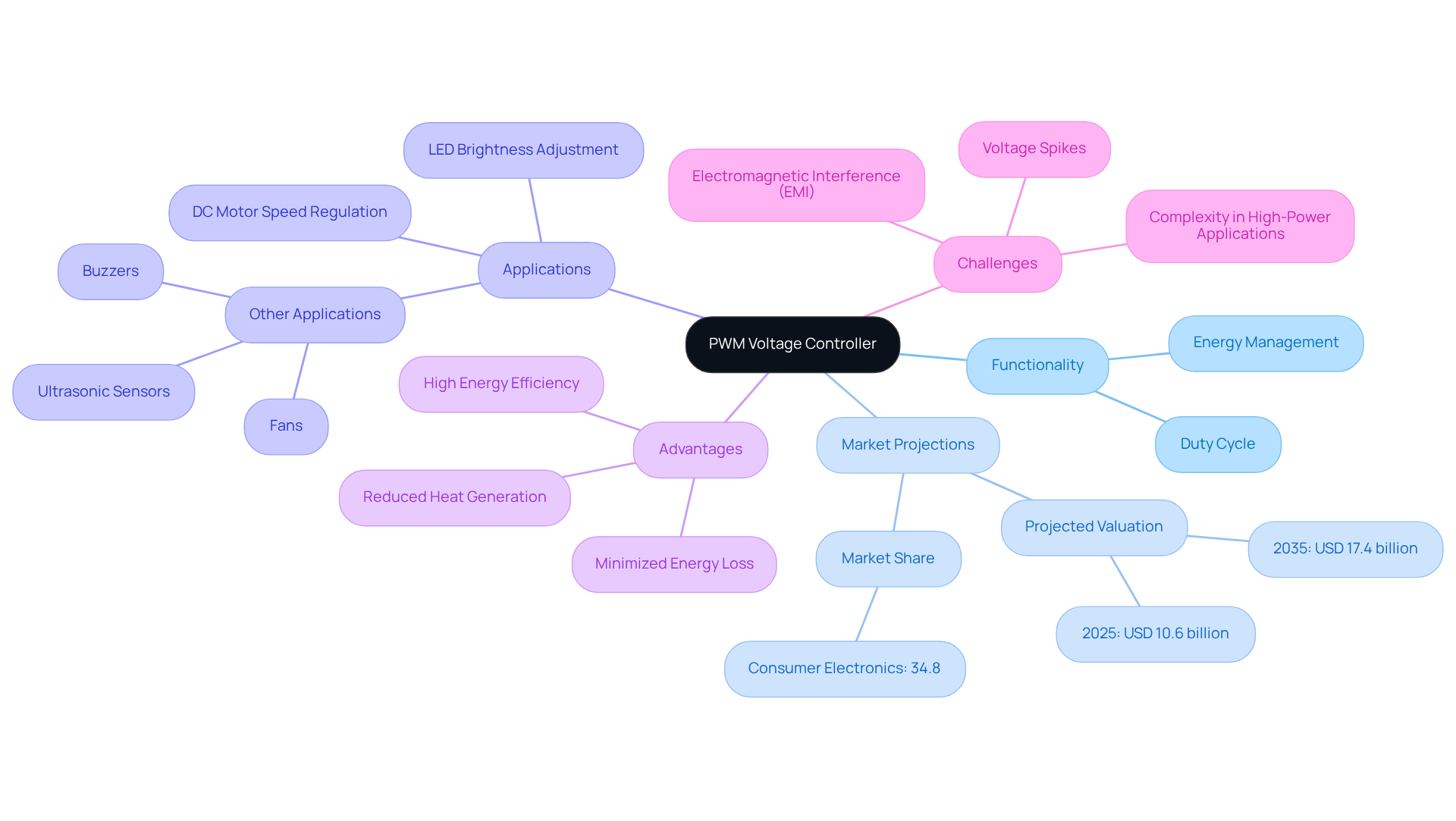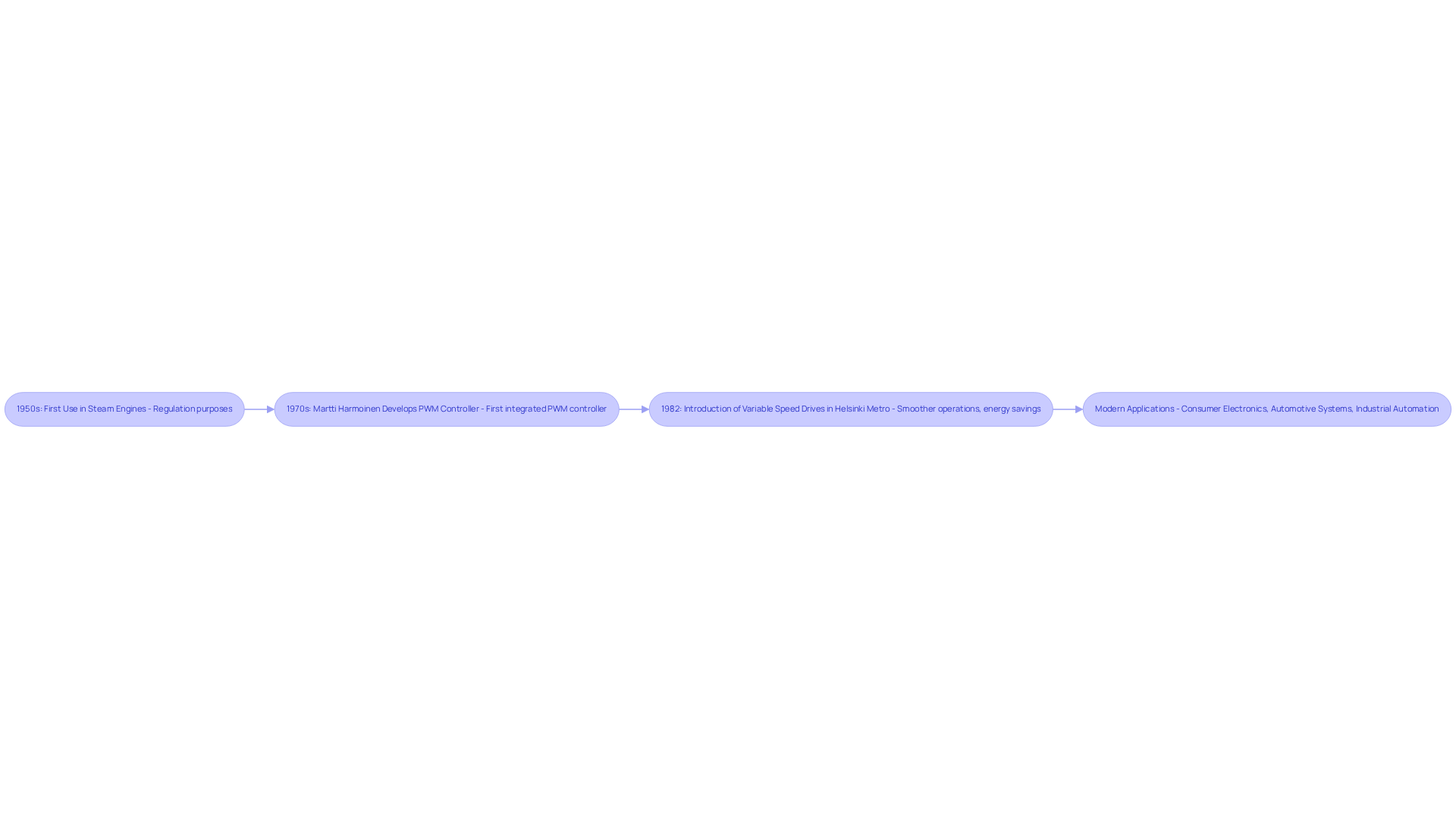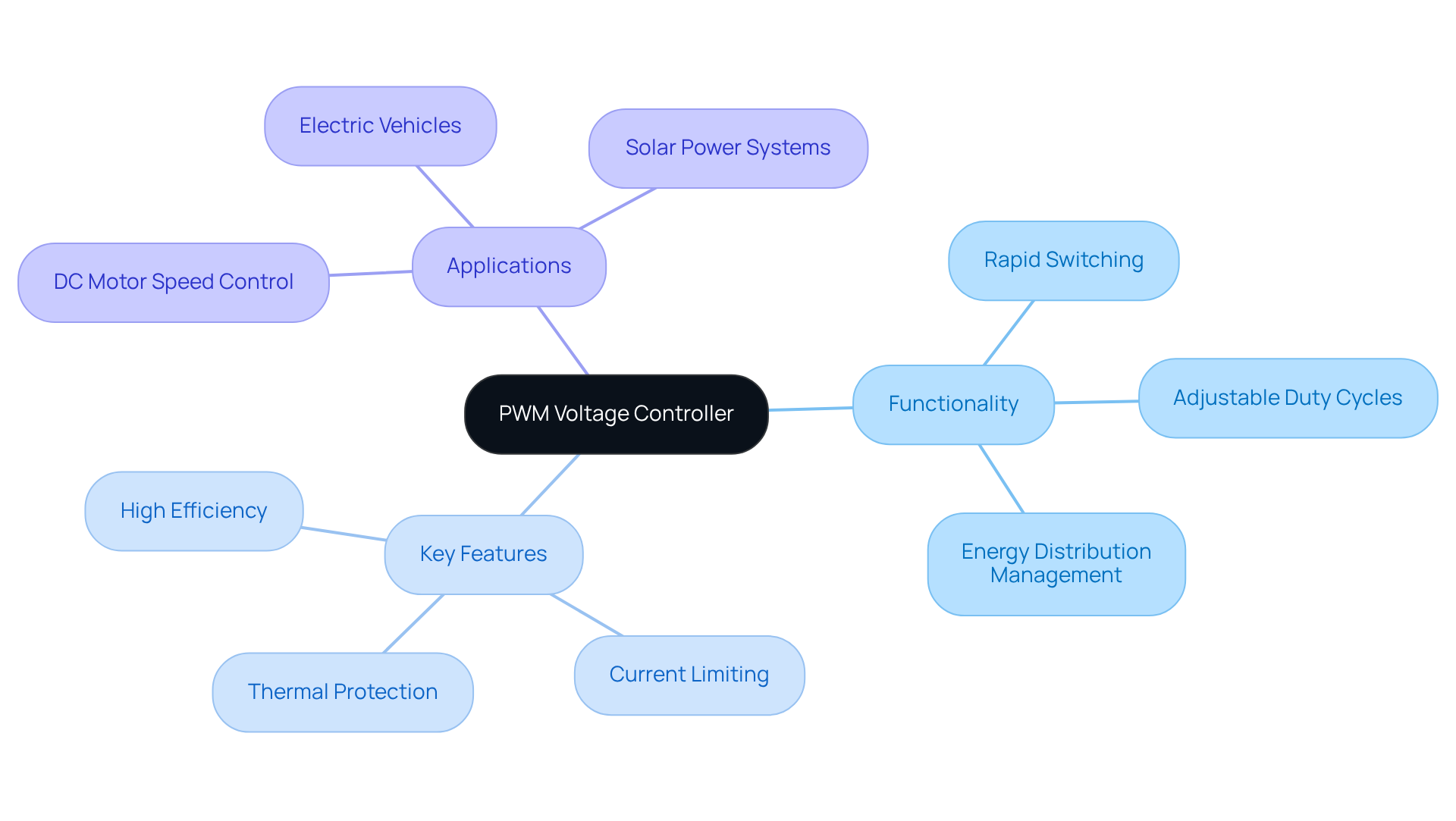Overview
A PWM voltage controller stands as a pivotal electronic device, expertly regulating output voltage by adjusting the width of pulses in a digital signal. This capability not only facilitates efficient energy management across a variety of applications but also underscores its importance in modern electronics.
Historically, PWM voltage controllers have evolved significantly, finding widespread application in areas such as motor control and LED dimming. Their design incorporates key features like high efficiency and thermal protection, which are critical for ensuring reliable performance in demanding environments.
The impact of PWM voltage controllers is evident in their ability to enhance energy efficiency and extend the lifespan of electronic components. By managing power delivery with precision, these controllers contribute to the overall effectiveness of electronic systems.
In conclusion, the PWM voltage controller is not merely an accessory but a fundamental component in the realm of electronics. Its role in optimizing performance and energy consumption makes it indispensable for engineers and technicians alike, driving innovation and efficiency in various technological applications.
Introduction
The PWM voltage controller is a cornerstone of modern electronics, driving efficient energy management through the precise adjustment of pulse width in digital signals. This cutting-edge technology not only boosts the performance of devices such as motors and LEDs but also plays a crucial role in energy conservation across a wide range of applications.
However, as the adoption of PWM technology accelerates, engineers encounter significant challenges, including:
- Voltage spikes
- Electromagnetic interference
These drawbacks can have serious implications for device performance and reliability. Understanding the intricacies of PWM voltage controllers is essential for professionals aiming to optimize their designs and mitigate these issues.
By grasping the complexities involved, engineers can enhance their designs, ensuring that the benefits of PWM technology are fully realized while minimizing potential drawbacks. This knowledge empowers them to create more efficient, reliable systems that meet the demands of today’s fast-paced technological landscape.
Define PWM Voltage Controller
A PWM voltage controller is an essential electronic device that regulates the output voltage supplied to a load by varying the width of the pulses in a digital signal. This method allows for effective energy distribution management, enabling devices to operate at various energy levels without the need for complex analog circuitry. By adjusting the duty cycle—the ratio of the ‘on’ duration to the total cycle time—PWM voltage controllers efficiently manage the average voltage and current supplied to motors, LEDs, and other electronic components using their functionality. This capability makes them crucial in applications ranging from energy sources to motor control systems.
In 2025, the market for PWM voltage controllers is projected to reach a valuation of USD 10.6 billion, capturing a significant share of the electronics industry. Notably, the consumer electronics segment is expected to hold a 34.8% market share. Experts highlight that PWM technology not only enhances energy efficiency and reduces heat generation but also minimizes energy loss in switching devices and is compatible with digital systems. Practical applications of PWM voltage controllers include:
- Regulating the speed of DC motors in automotive systems
- Adjusting the brightness of LED lighting
This showcases their versatility and effectiveness in modern electronics.
However, it is crucial to consider potential drawbacks of PWM technology, such as voltage spikes and electromagnetic interference (EMI). These factors are important considerations for engineers when implementing PWM solutions. Understanding both the advantages and challenges of using a PWM voltage controller will empower professionals to make informed decisions in their applications.

Contextualize PWM in Electronics
The pwm voltage controller is a pivotal method in electronics, enabling precise regulation of the average energy supplied to devices while significantly reducing energy loss. This technique finds extensive application in various domains, including motor speed control, LED dimming, and the use of a pwm voltage controller for power supply regulation.
For instance, PWM allows for seamless speed adjustments in motors, achieving energy savings of up to 30% by eliminating the heat generation commonly associated with resistive methods. In the realm of LED lighting, PWM facilitates flicker-free dimming, thereby enhancing user experience while ensuring energy efficiency.
Notably, over 70% of electronics engineers are now integrating PWM fans into their designs, a testament to the technology’s effectiveness in optimizing thermal management and bolstering system stability. As one engineer aptly noted, “Over 70% of electronics engineers are incorporating PWM fans into their designs,” highlighting the widespread acceptance of this innovative approach.
Moreover, the pwm voltage controller plays a critical role in renewable energy systems by adeptly managing output from solar panels and wind turbines, which enhances overall energy efficiency in electronic applications. Additionally, the PWM voltage controller in PWM Triac technology further refines PWM applications by providing effective management in AC power systems, making it a versatile choice for diverse electronic needs.

Trace the Origin of PWM Technology
The origins of Pulse Width Modulation (PWM) technology date back to the 1950s, where it was first utilized in steam engines for regulation purposes. This innovative method soon found its way into electrical applications, marking the start of PWM’s significant journey. A pivotal moment occurred in the 1970s with Martti Harmoinen’s development of the first integrated PWM controller, laying the groundwork for its widespread adoption in switching power supplies and motor management systems. The introduction of variable speed drives during this era revolutionized industrial efficiency, exemplified by their implementation in Helsinki’s metro trains in 1982, which enabled smoother operations and substantial energy savings.
As technology progressed, enhancements in microcontroller capabilities further refined PWM functionalities, allowing for the integration of more sophisticated algorithms. This evolution has solidified the pwm voltage controller as a fundamental component in modern electronic design, with applications that span consumer electronics, automotive systems, and industrial automation.
The legacy of pioneers like Martti Harmoinen, who was instrumental in developing PWM technology, continues to resonate within the field. His contributions have been crucial in shaping PWM’s trajectory, as evidenced by the multitude of patents filed since the 1970s, showcasing ongoing innovation and refinement in this vital area of electronics. The initial business application of SAMI A technology at the Karihaara sawmill highlighted the technology’s benefits in an industrial setting, further cementing PWM’s role in effective electronic management. Today, PWM stands as a cornerstone of efficient electronic management, essential for advancing innovative technologies across diverse sectors.

Examine Functionality and Key Features
In modern electronics, the PWM voltage controller is pivotal as it operates by rapidly switching the output voltage on and off to create a series of pulses. By modulating the width of these pulses, the PWM voltage controller effectively regulates the average voltage supplied to the load, making adjustable duty cycles a fundamental feature. This capability allows for precise energy distribution management, which is crucial in various applications, including motor regulation and LED dimming.
For example, the PWM voltage controller is extensively utilized in controlling DC motor speed. They enable smooth acceleration and deceleration by varying the pulse width, directly influencing the motor’s speed. This method can enhance efficiency by up to 30% compared to traditional control methods, significantly reducing wasted energy and heat generation.
Key features of the PWM voltage controller include:
- High efficiency
- Current limiting
- Thermal protection
These features all contribute to enhanced reliability and performance in demanding environments. Real-world applications showcase the versatility of the PWM voltage controller; in electric vehicles, this controller optimizes battery usage by managing energy delivery to various components, thereby improving range and performance. Similarly, in solar power systems, the PWM voltage controller, like the 10A 12V 24V PWM Solar Controller, manages voltage between solar panels and batteries, ensuring optimal operation and safeguarding against overcharging.
PWM frequencies can vary from a few hertz to several kilohertz or even megahertz, further expanding their range of applications. These instances underscore the critical role of PWM technology in modern electronics, where efficiency and precision are paramount.

Conclusion
A PWM voltage controller stands as a crucial element in the field of electronics, delivering efficient output voltage regulation through the precise modulation of pulse widths. This technology not only optimizes energy management but also offers versatility across a range of applications, from motor control to LED dimming. For engineers and designers, grasping the functionality and significance of PWM voltage controllers is essential for enhancing electronic systems.
This article has delved into key insights regarding the workings, historical evolution, and extensive applications of PWM technology. The journey of PWM from its origins in steam engines to its current role in sophisticated electronic designs underscores its vital contribution to energy efficiency and heat reduction. Moreover, the anticipated market growth highlights the increasing dependence on PWM technology across various sectors.
Given the pivotal role that PWM voltage controllers play in contemporary electronics, professionals are urged to adopt this technology to boost system performance and energy efficiency. As the demand for sustainable and efficient electronic solutions escalates, harnessing the capabilities of PWM can drive significant advancements in both industrial and consumer applications.
Frequently Asked Questions
What is a PWM voltage controller?
A PWM voltage controller is an electronic device that regulates the output voltage to a load by varying the width of the pulses in a digital signal, allowing for effective energy distribution management.
How does a PWM voltage controller work?
It works by adjusting the duty cycle, which is the ratio of the ‘on’ duration to the total cycle time, to efficiently manage the average voltage and current supplied to devices like motors and LEDs.
What are the benefits of using PWM voltage controllers?
PWM voltage controllers enhance energy efficiency, reduce heat generation, minimize energy loss in switching devices, and are compatible with digital systems.
What is the projected market value for PWM voltage controllers in 2025?
The market for PWM voltage controllers is projected to reach a valuation of USD 10.6 billion in 2025.
What segment is expected to hold the largest market share for PWM voltage controllers?
The consumer electronics segment is expected to hold a 34.8% market share.
What are some practical applications of PWM voltage controllers?
Practical applications include regulating the speed of DC motors in automotive systems and adjusting the brightness of LED lighting.
What are some potential drawbacks of PWM technology?
Potential drawbacks include voltage spikes and electromagnetic interference (EMI), which are important considerations for engineers when implementing PWM solutions.
Why is it important to understand both the advantages and challenges of PWM voltage controllers?
Understanding both aspects empowers professionals to make informed decisions regarding the use of PWM voltage controllers in their applications.

